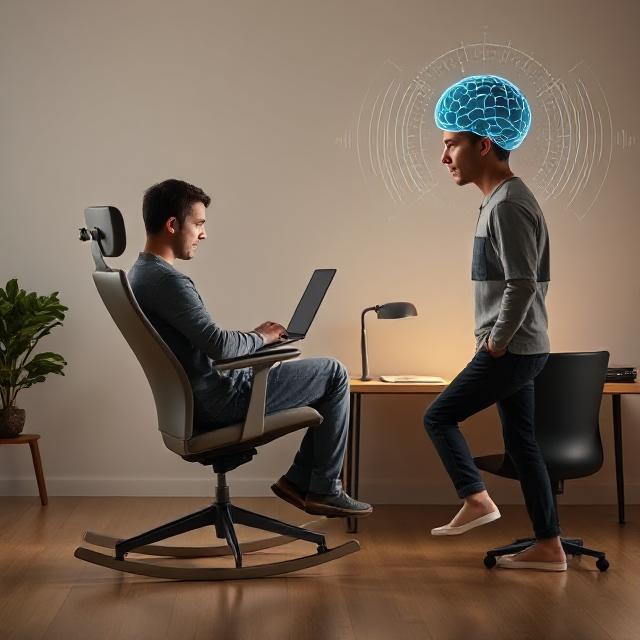
Table of Contents
How Micro-Movements (Rocking, Pacing) Aid Concentration
TL;DR
Pacing, rocking, tapping—these seemingly mindless movements are not distractions. They’re neurological regulators, helping your brain synchronize attention, memory, and stress reduction. Micro-movements, when consciously integrated into your focus rituals, can stabilize arousal levels, release excess cognitive load, and unlock smoother transitions into flow.
I. The Myth of Stillness
For centuries, focused attention has been wrongly equated with physical stillness. Yet the human brain evolved for movement. Sitting perfectly still during cognitive tasks can cause:
- Build-up of cortisol and mental fatigue
- Overactivation of the default mode network (DMN)
- Decreased oxygenation and sensory input
In contrast, subtle, rhythmic movements help maintain neurological balance, making it easier to sustain high-quality attention.
II. What Are Micro-Movements?
Micro-movements are small, repetitive motor behaviors that don’t require conscious attention. Common examples include:
- Rocking in a chair
- Pacing slowly while thinking
- Finger tapping or foot bouncing
- Rhythmic breathing with head swaying
- Chair swiveling or toe curling
Unlike full-body movement (like exercise), micro-movements stimulate proprioception and maintain alertness without breaking your concentration cycle.
III. Brainwave Effects of Repetitive Movement
Rhythmic micro-movement entrains the brain into predictable wave states. Here’s how:
| Movement Type | Likely Brainwave Impact |
|---|---|
| Rocking | Increases alpha-theta synchronization |
| Pacing | Boosts low-beta and SMR for clarity |
| Tapping/fidgeting | Reduces DMN activity, keeps beta sharp |
Micro-movements generate sensorimotor feedback, gently keeping the prefrontal cortex online while reducing tension in the limbic system—a sweet spot for calm concentration.
IV. Movement as a Regulator of Arousal
The Yerkes-Dodson Law describes how performance improves with arousal—up to a point. Too little stimulation = boredom. Too much = stress.
Micro-movements:
- Act as self-calibration mechanisms
- Disperse excess energy or anxiety (hyperarousal)
- Stimulate sluggish minds (hypoarousal)
- Provide somatic focus anchors during difficult tasks
This is why neurodivergent thinkers (e.g. ADHD, autism) often rely on fidgeting: it organically regulates their nervous system without conscious mental effort.
V. How Rocking and Pacing Affect Cognitive Load
Mental overload builds cognitive residue—unprocessed thoughts or emotions that block flow. Gentle rhythmic movements can:
- Decrease amygdala activity
- Stabilize breath and heartbeat rhythms
- Signal safety to the brain via the vagus nerve
- Improve working memory access by activating the dorsolateral prefrontal cortex
In short, micro-movements soften the noise, allowing your mind to tunnel into the signal.
VI. Research Evidence Supporting Kinetic Focus
Key findings from recent neuroscience:
- 2021 (Journal of Cognitive Neuroscience): Light repetitive motion improved math task accuracy and engagement in students.
- 2019 (Frontiers in Psychology): Rocking activated hippocampal networks, improving sleep quality and memory—suggesting it could aid memory recall in wakefulness too.
- 2018 (Neuropsychologia): Controlled fidgeting helped executive functioning and task-switching in high-demand work sessions.
- 2016 (Psychonomic Bulletin & Review): Participants allowed to pace during problem-solving performed 17% better on insight tasks.
VII. Integrating Micro-Movement into Your Work Routine
🔧 Low-Disruption Micro-Movement Hacks
| Tactic | How to Use |
|---|---|
| Rocking desk chair | Let your body sway lightly while typing or reading |
| Standing pacing breaks | Walk slow, rhythmic laps every 25–30 minutes |
| Fidget objects | Use smooth stones, magnetic rings, or subtle finger toys |
| Foot roller | Roll your foot back and forth under the desk (stimulates nerves) |
| Kinetic breathing | Sway slightly with breath during focus resets |
These options support movement without distracting others or breaking task flow.
VIII. Movement and Flow: The Vestibular Connection
The vestibular system, responsible for balance and spatial orientation, plays a key role in flow regulation. Activating it via:
- Head swaying
- Gentle rocking
- Body shifting or shoulder rolls
…stimulates cerebellar and frontal lobe integration—which is essential for maintaining smooth executive control, spatial awareness, and time distortion often felt during deep flow.
IX. Movement Patterns for Different Focus States
| Focus Goal | Best Movement Strategy |
|---|---|
| Creative ideation | Pacing, walking in circles, light head bobbing |
| Deep analytical work | Subtle rocking, seated foot taps, micro-fidgeting |
| Transitioning into focus | Breath-synchronized body sways or dynamic stretches |
| Fighting mental fatigue | Upright pacing or desk pushbacks every 25 minutes |
| Regaining calm after stress | Seated rocking, slow shoulder rotations, humming |
X. A Sample Focus Routine with Micro-Movement
5-Minute Prep Protocol:
- Hydrate + stand up
- Pace gently for 2 minutes while repeating a focus mantra
- “Clarity comes with motion.”
- Rock or sway gently with 2 minutes of box breathing
- Sit in a rocking chair or allow gentle back-and-forth motion as you begin work
Repeat pacing or foot movements every 30–45 minutes.
Final Thoughts: Move to Focus, Don’t Fight It
Stillness isn’t always a virtue. Your brain thrives on predictable kinetic patterns—subtle, rhythmic micro-movements that discharge stress, regulate arousal, and cue the nervous system into a state of readiness.
Next time you feel your focus slipping, don’t freeze up. Move.
Pace. Rock. Tap. Sway.
Let your body guide your brain back into the groove.
